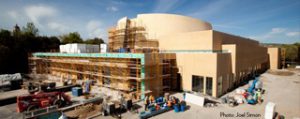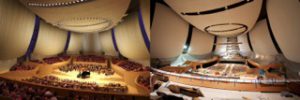Table of Contents
When Stanford Symphony Orchestra held a rehearsal on Monday, November 5, Orchestra Committee President Jeremy Hsu says there was a “tremendous amount of excitement, and a tangible buzz among the musicians.” That day, the student Orchestra was holding its first rehearsal in the brand new Bing Concert Hall, a state-of-the-art facility that will open its doors to the public in January of next year. The new hall will replace Dinkelspiel Auditorium as the new home of the student Orchestra, but it will also attract world-class musicians from around the world, engaging not only the local community but also improving the educational music programs that Stanford offers its student talent. Located on the east end of Museum Way, directly across from Cantor Arts Center, the new venue is an integral part of the Stanford Arts Initiative’s commitment to improving the University’s arts facilities and the centerpiece of the developing Stanford ‘Arts District’.
there was a “tremendous amount of excitement, and a tangible buzz among the musicians.” That day, the student Orchestra was holding its first rehearsal in the brand new Bing Concert Hall, a state-of-the-art facility that will open its doors to the public in January of next year. The new hall will replace Dinkelspiel Auditorium as the new home of the student Orchestra, but it will also attract world-class musicians from around the world, engaging not only the local community but also improving the educational music programs that Stanford offers its student talent. Located on the east end of Museum Way, directly across from Cantor Arts Center, the new venue is an integral part of the Stanford Arts Initiative’s commitment to improving the University’s arts facilities and the centerpiece of the developing Stanford ‘Arts District’.
The venue, which was designed by Ennead Architects, a world-renowned firm that is also responsible for Carnegie Hall, the Cantor Arts Center, the William Neukom Law School Building, and the Clinton Presidential Library, includes both an 844-seat concert hall and a 2,300 square foot studio that can be used for rehearsal and performance. The seats are arranged in a vineyard formation around the stage, which is on the same level as the first row of seats. Dr. Yasuhisa Toyota of Nagata Acoustics, who was also responsible for the Disney Concert Hall in Los Angeles, was brought in to design acoustics that would complement the seating arrangements.
Jenny Bilfield, Artistic Director of Stanford Live, explains that the unique architectural design “ensures every seat has fantastic sightlines to the performers, and that the performers can sense the audience in a palpable, present way”, while the acoustics allow  “visitors to be able to hear the performers and for the performers (students or visiting artists) to properly hear themselves.” This hall is designed to “create a sense of intimacy and connection between audience and performers,” Billfield says, in order “to support live performance in a way that other venues cannot.”
“visitors to be able to hear the performers and for the performers (students or visiting artists) to properly hear themselves.” This hall is designed to “create a sense of intimacy and connection between audience and performers,” Billfield says, in order “to support live performance in a way that other venues cannot.”
For Jeremy Hsu, the truth of that statement is reflected in the quality of artists the new facility is attracting. “In terms of programming,” Hsu said, “I think you’re already seeing the impact of having such a great new facility!” Stanford Live will be featuring world-class musicians like Yo-Yo Ma, Midori, and Emanuel Ax in its inaugural season, Hsu explained, and the Stanford Student Orchestra’s has committed to the Beethoven Project, a yearlong celebration of “Beethoven’s artistic genius that encompasses performances of all nine symphonies and all five piano concertos.” He explained that it is very “rare to see an orchestra take on all the symphonies and piano concertos in one season, but there is no better place to present all those works than in Bing.”
The Stanford Student Orchestra is not the only group whose musical talent will take center stage in this new state-of-the-art facility. Bob Cable, Media Director for Stanford Live, says that student groups like “SLOrk, Stanford Taiko, Stanford Talisman, and others will be a part of the Opening Weekend Festivities running January 11-13.” Those groups will join Michael Tilson Thomas and the San Francisco Symphony Orchestra, the St. Lawrence String Quartet, the Stanford Chamber Chorale, and world-famous band Los Lobos in celebrating the Bing Concert Hall’s opening.
Stanford student musicians in those groups, however, should not be the only students looking forward to the opening of this new venue. In addition to bringing together audiences and performers, Bing was intended to facilitate education in multiple areas through the intersection of performance and teaching. Students and faculty in the Center for Computer Research in Music and Acoustics will  have a chance to experience the sound design they created for the new hall, while those lighting, amplification, and recording systems will also offer a learning opportunity for current and future students in the CCRMA program. The stage, which can topographically altered through six mechanical lifts, is a study in engineering, while the collaboration between faculty composer Jonathan Berger, writer Dan O’Brien, director Rinde Ekert, and the St. Lawrence String Quartet will offer students the chance to learn about opera composition. For those who are simply looking to hear a great show, Stanford Live offers students the chance to see these world-renowned artists at the discounted price of ten dollars.
have a chance to experience the sound design they created for the new hall, while those lighting, amplification, and recording systems will also offer a learning opportunity for current and future students in the CCRMA program. The stage, which can topographically altered through six mechanical lifts, is a study in engineering, while the collaboration between faculty composer Jonathan Berger, writer Dan O’Brien, director Rinde Ekert, and the St. Lawrence String Quartet will offer students the chance to learn about opera composition. For those who are simply looking to hear a great show, Stanford Live offers students the chance to see these world-renowned artists at the discounted price of ten dollars.
Come January, the “tangible buzz” amongst the Stanford Student Orchestra during their first rehearsal in Bing will spread to the entire university community and the Bay Area arts scene beyond. The new Bing Concert Hall and all of the opportunities it creates are, as Jeremy Hsu put it, really “the beginning of a new era for Stanford.”




